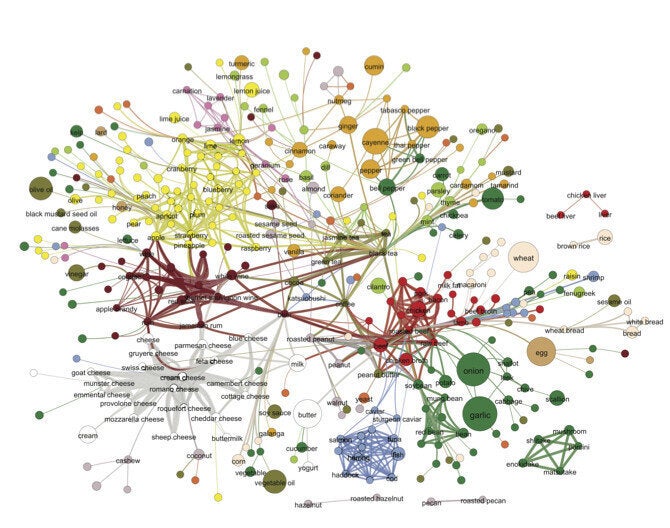
Many differences divide traditional North American and Asian food cultures -- cooking methods, dining habits, famous recipes. They each have signature ingredients -- think of soy sauce, ginger and sriracha in Southeast Asian food or butter and molasses in Southern food. But a new study from an international team led by Yong-Yeol Ahn and Sebastian Ahnert, published in Scientific Reports, shows that there are actually deeper patterns at play.
It turns out North American and Western European cuisines tend to include ingredients with similar flavor molecules together in one recipe, while East Asian and Southern European cuisines tend not to. That means that the ingredients in most recipes traditionally associated with Western cuisine overlap and deepen each others' constituent flavors, while those in Asian recipes tend to bristle against one another with distinctive flavors.
The researchers discovered this trend by analyzing recipes they found online at AllRecipes and Epicurious. They downloaded the tens of thousands of recipes available on each of those databases, then added added data on the underlying flavor molecules that make each ingredient taste the way it does.
The process of appending flavor molecule information to ingredients allowed them to find the degree of taste-similarity of any given pair of ingredients. This in itself led to some interesting findings -- including the "flavor network" visualized above, which divides the world of ingredients into different zones of similar flavor groups. That allowed the researchers to empirically demonstrate the overlap in flavors between alcohols and fruits, between vegetables and herbs and between meats and beans.
But the real interest of the study comes through its application of this raw data to differences in cultures' cuisines. After a lot of dense statistical analysis, the researchers found that much of the divide between the flavor-coordination tendencies of each cuisine can be ascribed to the prevalence of just a few ingredients.
The harmoniousness of North American cuisine's flavors really stems from its reliance on a few heavy-tasting products commonly associated with baked goods, especially milk, butter, cocoa, vanilla, cream, cream cheese, egg, peanut butter and strawberries. And the study chalked the dissonance of East Asian cuisine up to its use of beef, ginger, pork, cayenne, chicken and onion. These ingredients are characteristic of each cultures' recipes -- and share relatively many flavor molecules, and relatively few flavor molecules, respectively, with the ingredients they're often paired with.
One intriguing nugget from the study, though, bodes well for the future careers of the world's ambitious chefs. In the introduction to the piece, the researchers note that the ingredients they found in their two recipe databases could theoretically be combined into 10 quadrillion recipes -- of which only one million, just .0000001%, have already been recorded.
